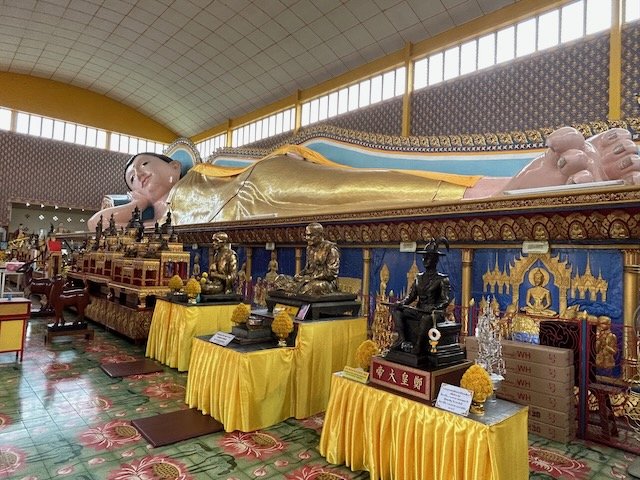Plastic Water Bottles, Rice Bowls, and Incense
“Someone left some trash on the Budha! How disrespectful!”, I mentioned to the caretaker of the Burmese Budhist Temple we recently visited. At the foot of the extremely large Budha residing in the temple, someone had left a plastic water bottle, which I thought was very insensitive. “Oh, I actually put that there,” the caretaker replied, “because he gets thirsty. We give him food for lunch then, afterward, we must give him water because he is thirsty. I used to put the water in a lovely glass with a saucer, but the neighborhood children would come and drink the water and, in so doing, would make a big mess, so I started putting the water in the plastic bottle instead.” “Ahhhhh! I see!” I replied and thought to myself how very interesting this belief was.
One thing we really enjoy doing on this journey is learning about the cultures and beliefs of the people in the countries we visit. Penang, Malaysia, is a huge melting pot of cultures and religions. In the 19th Century, traders flocked to Penang because it was developed by the British East India Company as a trading port with goods going in and out to countries all over this region of the world and beyond.
Incoming migrants flooded Georgetown, the city center, mostly hailing from Southern Chinese, Indian, Eurasian and Siamese (Thai) origins, in effect turning Georgetown into a melting pot of cultures and religions. This is evident even today with very distinct people groups with their unique food, culture, beliefs and customs living side-by-side and doing daily life together. To outsiders, it looks like it all works in relative harmony, but several locals have told us the reality is otherwise. That, however, is for a different blog post.
It is fascinating to explore and learn about each of the groups in this melting pot and especially to find out about their unique religious beliefs. We’ve wanted to learn at least a little about each of the main religions practiced here in Penang so, during the 7 weeks we’ve been here, we’ve made a point to visit houses of worship for Hinduism, Buddhism, Islam, and Taoism.
Interesting Observations From Each One
In the Taoist temple, there were sections set up for worshippers to give homage to their deceased loved ones. Hundreds of name cards lined up on rows of tables, each one had an offering of a bowl of rice and a bowl of mixed vegetables and tofu. We’d never seen anything like it! You can see a photo of this in the gallery below.
We visited two Buddhist temples, one that is Thai and one Burmese. They are very unique; the Thai temple has the largest reclining Budha in Southeast Asia while the Burmese one has a massive standing Budha. Both of these temples were fascinating with tons of shiny gold and rich wood throughout. One thing that surprised us was how many different smaller Budha statues were posed throughout each of these temples, all having their own devotees. The large reclining Budha was quite a sight to see. He is reclining on top of a huge mausoleum where there are thousands of glassed-in concrete boxes housing the remains of loved ones in beautiful ceramic urns. There are photos of these in the gallery below.
There are dozens of Hindu temples in Penang, all of various sizes. Very colorful and ornate, they are built mostly of stone and stone carvings painted with bright colors. Penang has practised religious tolerance since it became a British port until now, and you’ll see diverse places of worship built very close to one another. The perfect example is a street in Georgetown called Jalan Masjid Kapitan Keling, also known as the Street of Harmony, where the Kapitan Keling Mosque, Goddess of Mercy Temple, St. George's Anglican Church and Sri Maha Mariamman Temple all sit within walking distance.
When visiting a mosque, women will be asked to cover their heads and shoulders and both men and women will be asked to cover their legs. Of course, you’ll also be asked to remove your shoes, which is true at the other houses of worship as well. If you come unprepared, most mosques will provide covers for you, usually at no cost, but sometimes for a nominal fee. We find mosques to be quite beautiful with their huge prayer rooms, massive domed ceilings and elaborate Arabic caligraphy displaying the names of God on the walls and around the ceilings. Somewhere on the outside of each mosque will be a large speaker from which the call to prayer is sounded five times a day.
We ourselves are followers of Jesus Christ, so we found a Christian church to attend on a regular basis while we’re here, but we wanted to understand a bit about each of the religions practiced by the people of Penang. It’s been most interesting and, at times, very moving, as we have observed the same thing in each one: all humans have the same longings and are seeking the answers to them.
Thank you for taking the time to read this post. We hope you can take a few minutes to scroll through the photos in the gallery. Better yet, we recommend making a trip to see Penang and its wealth of interest and intrigue for yourselves!






















